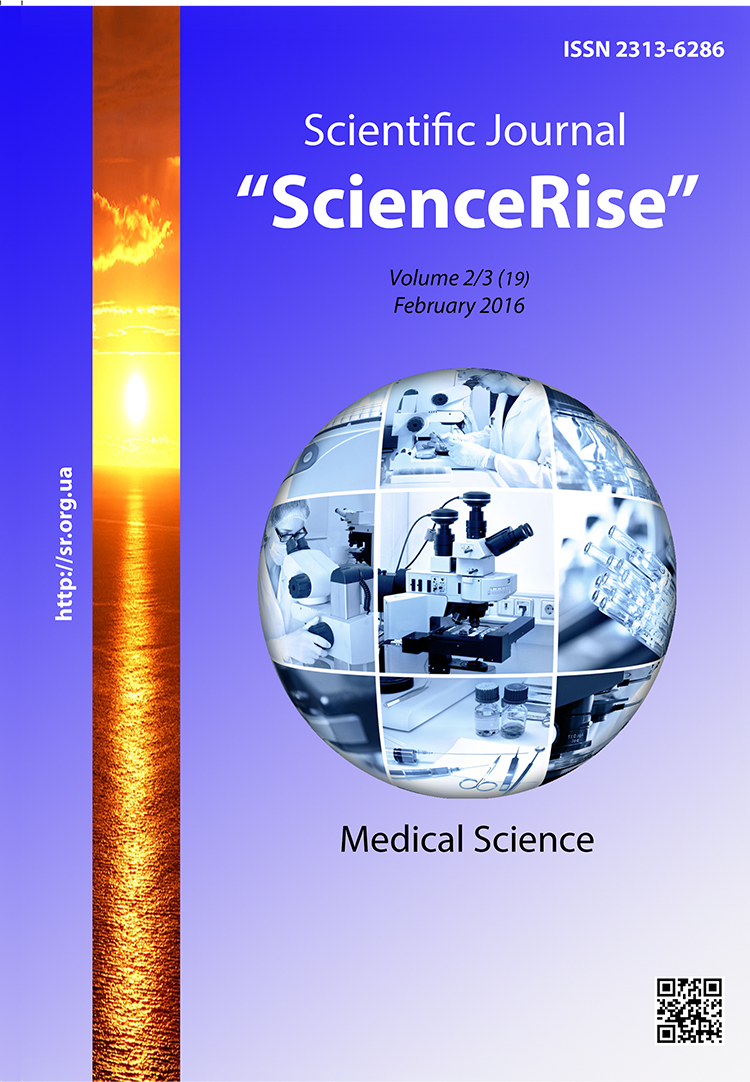Інформативність клінічних параметрів метаболічного синдрому при первинному гострому ішемічному інсульті
DOI:
https://doi.org/10.15587/2313-8416.2016.61223Ключові слова:
метаболічний синдром, ішемічний інсульт, компоненти метаболічного синдромуАнотація
Метою роботи було проведення оцінки інформативності клінічних параметрів метаболічного синдрому та їх кількісний вплив у пацієнтів на первинний гострий ішемічний інсульт. За результатами проведеного дослідження, виявлено негативний кількісний вплив клінічних параметрів метаболічного синдрому у виникненні церебральної катастрофи. Зі збільшенням числа компонентів синдрому відмічалась залежність у вираженості показників системної гемодинаміки, поглиблення атеротромботичного потенціалу за даними ліпідного спектру крові та вираженості метаболічно-вуглеводних порушень
Посилання
Faralli, A., Bigoni, M., Mauro, A., Rossi, F., Carulli, D. (2013). Noninvasive Strategies to Promote Functional Recovery after Stroke. Neural Plasticity, 2013, 1–16. doi: 10.1155/2013/854597
Grimaud, O., Bejot, Y., Heritage, Z., Vallee, J., Durier, J., Cadot, E. et. al (2011). Incidence of Stroke and Socioeconomic Neighborhood Characteristics: An Ecological Analysis of Dijon Stroke Registry. Stroke, 42 (5), 1201–1206. doi: 10.1161/strokeaha.110.596429
Hobzej, M. K., Zinchenko, O. M., Golubchykov, M. V. et. al (2013). Stan nevrologichnoi' sluzhby v Ukrai'ni u 2012 roci. Kharkiv, 29.
Mishhenko, T. S. (2014). Bor'ba s insul'tom: sostojanie medicinskoj pomoshhi v Ukraine i v mire. Mezhdunarodnyj nevrologicheskij zhurnal, 7 (69), 2–7.
Zozulja, I. S., Zozulja, A. I. (2015). Likuvannja hvoryh na mozkovyj insul't. Ukr. med. Chasopys, 1 (105), 36–39.
Soler, E. P., Ruiz, V. C. (2010). Epidemiology and Risk Factors of Cerebral Ischemia and Ischemic Heart Diseases: Similarities and Differences. Current Cardiology Reviews, 6 (3), 138–149. doi: 10.2174/157340310791658785
Cortez-Dias, N., Martins, S., Belo, A. et. al (2011). Comparison of definitions of metabolic syndrome in relation to risk for coronary artery disease and stroke. Rev. Port. Cardiol., 30 (2), 139–169.
Air, E. L., Kissela, B. M. (2007). Diabetes, the Metabolic Syndrome, and Ischemic Stroke: Epidemiology and possible mechanisms. Diabetes Care, 30 (12), 3131–3140. doi: 10.2337/dc06-1537
Konradi, A. O., Rotar, O. P., Korostovtseva, L. S., Ivanenko, V. V., Solntcev, V. N., Anokhin, S. B. et. al (2011). Prevalence of Metabolic Syndrome Components in a Population of Bank Employees from St. Petersburg, Russia. Metabolic Syndrome and Related Disorders, 9 (5), 337–343. doi: 10.1089/met.2011.0028
Khang, Y.-H., Cho, S.-I., Kim, H.-R. (2010). Risks for cardiovascular disease, stroke, ischaemic heart disease, and diabetes mellitus associated with the metabolic syndrome using the new harmonised definition: Findings from nationally representative longitudinal data from an Asian population. Atherosclerosis, 213( 2), 579–585. doi: 10.1016/j.atherosclerosis.2010.09.009
Hwang, I.-C., Kim, K.-K., Jee, S.-H., Kang, H.-C. (2011). Comparison of Predictability of Cardiovascular Events between Each Metabolic Component in Patients with Metabolic Syndrome Based on the Revised National Cholesterol Education Program Criteria. Yonsei Medical Journal, 52 (2), 220. doi: 10.3349/ymj.2011.52.2.220
Liu, C., Feng, M., Fang, X. H. et al. (2011). Metabolic syndrome is an independent risk factor for cardiovascular disease events in patients with ischemic stroke. Zhonghua Xin Xue Guan Bing Za Zhi, 39 (4), 358–362. doi: 10.3760/cma.j.issn.0253-3758.2011.04.016
Alberti, K. G. M. M., Eckel, R. H., Grundy, S. M., Zimmet, P. Z., Cleeman, J. I., Donato, K. A. et. al (2009). Harmonizing the Metabolic Syndrome: A Joint Interim Statement of the International Diabetes Federation Task Force on Epidemiology and Prevention; National Heart, Lung, and Blood Institute; American Heart Association; World Heart Federation; International Atherosclerosis Society; and International Association for the Study of Obesity. Circulation, 120 (16), 1640–1645. doi: 10.1161/circulationaha.109.192644
Zhang, W.-W., Liu, C.-Y., Wang, Y.-J., Xu, Z.-Q., Chen, Y., Zhou, H.-D. (2009). Metabolic syndrome increases the risk of stroke: a 5-year follow-up study in a Chinese population. Journal of Neurology, 256 (9), 1493–1499. doi: 10.1007/s00415-009-5150-2
Wang, J., Ruotsalainen, S., Moilanen, L., Lepisto, P., Laakso, M., Kuusisto, J. (2008). The Metabolic Syndrome Predicts Incident Stroke: A 14-Year Follow-Up Study in Elderly People in Finland. Stroke, 39 (4), 1078–1083. doi: 10.1161/strokeaha.107.499830
##submission.downloads##
Опубліковано
Номер
Розділ
Ліцензія
Авторське право (c) 2016 Олександр Миколайович Дзюба, Василь Васильович Бабенко

Ця робота ліцензується відповідно до Creative Commons Attribution 4.0 International License.
Наше видання використовує положення про авторські права Creative Commons CC BY для журналів відкритого доступу.
Автори, які публікуються у цьому журналі, погоджуються з наступними умовами:
1. Автори залишають за собою право на авторство своєї роботи та передають журналу право першої публікації цієї роботи на умовах ліцензії Creative Commons CC BY, котра дозволяє іншим особам вільно розповсюджувати опубліковану роботу з обов'язковим посиланням на авторів оригінальної роботи та першу публікацію роботи у цьому журналі.
2. Автори мають право укладати самостійні додаткові угоди щодо неексклюзивного розповсюдження роботи у тому вигляді, в якому вона була опублікована цим журналом (наприклад, розміщувати роботу в електронному сховищі установи або публікувати у складі монографії), за умови збереження посилання на першу публікацію роботи у цьому журналі.

